Localization of Partial Discharges in Hydrogenerators by Ozone Emission
Abstract
:1. Introduction
2. Materials and Methods
3. Fluid Dynamics Theory
3.1. Basic Equations and Boundary Conditions
3.2. Fluid Dynamics Applied to Ozone
4. Numerical Model
4.1. A General Description
4.2. Numerical Mesh
5. Results and Discussion
6. Conclusions
Author Contributions
Funding
Data Availability Statement
Acknowledgments
Conflicts of Interest
Abbreviations
| AMD | Advanced Micro Devices |
| CFD | Computational fluid dynamics |
| PD | Partial discharges |
| RAM | Random-access memory |
Appendix A. Validation of CFD Model Using Stator Bar Experiments
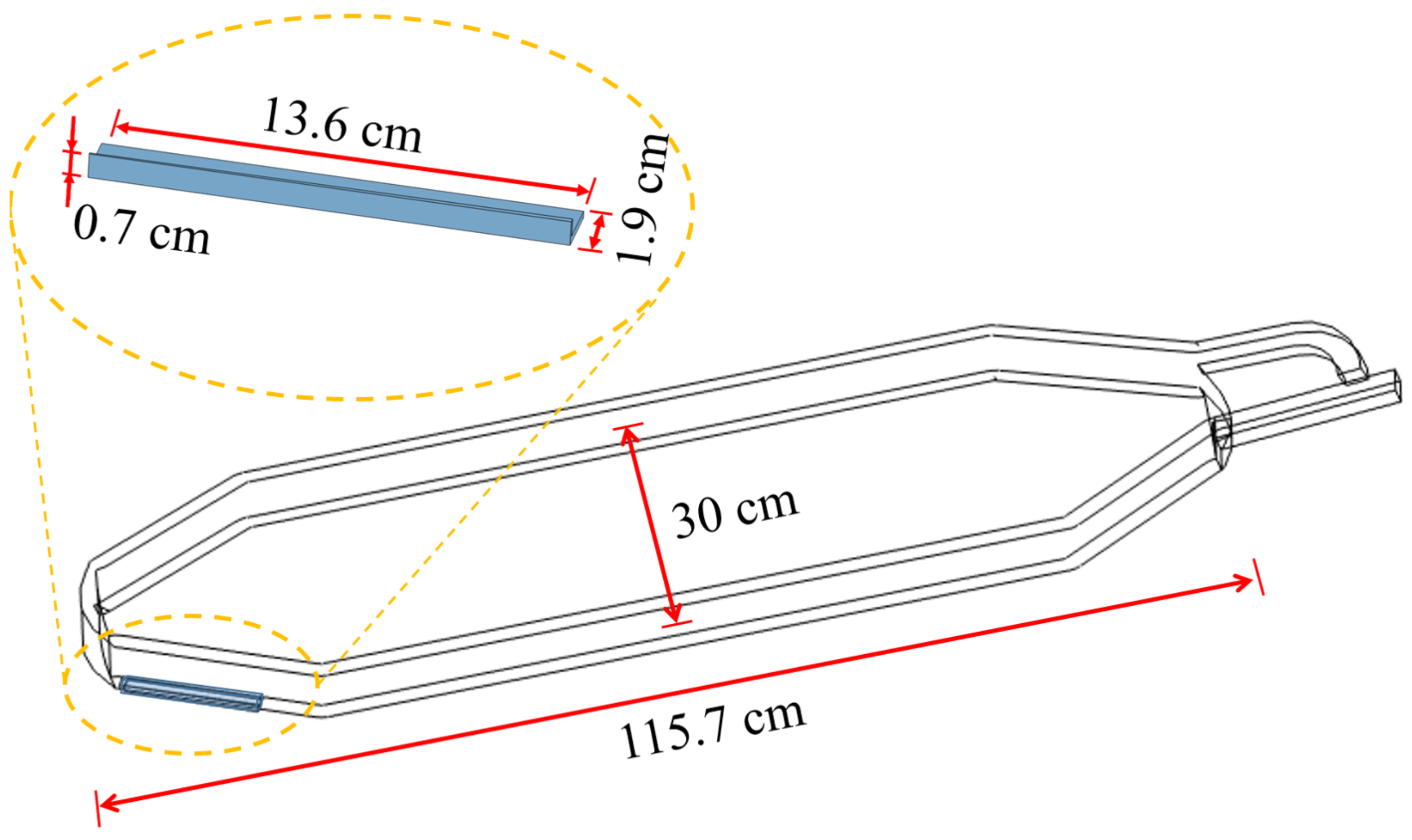


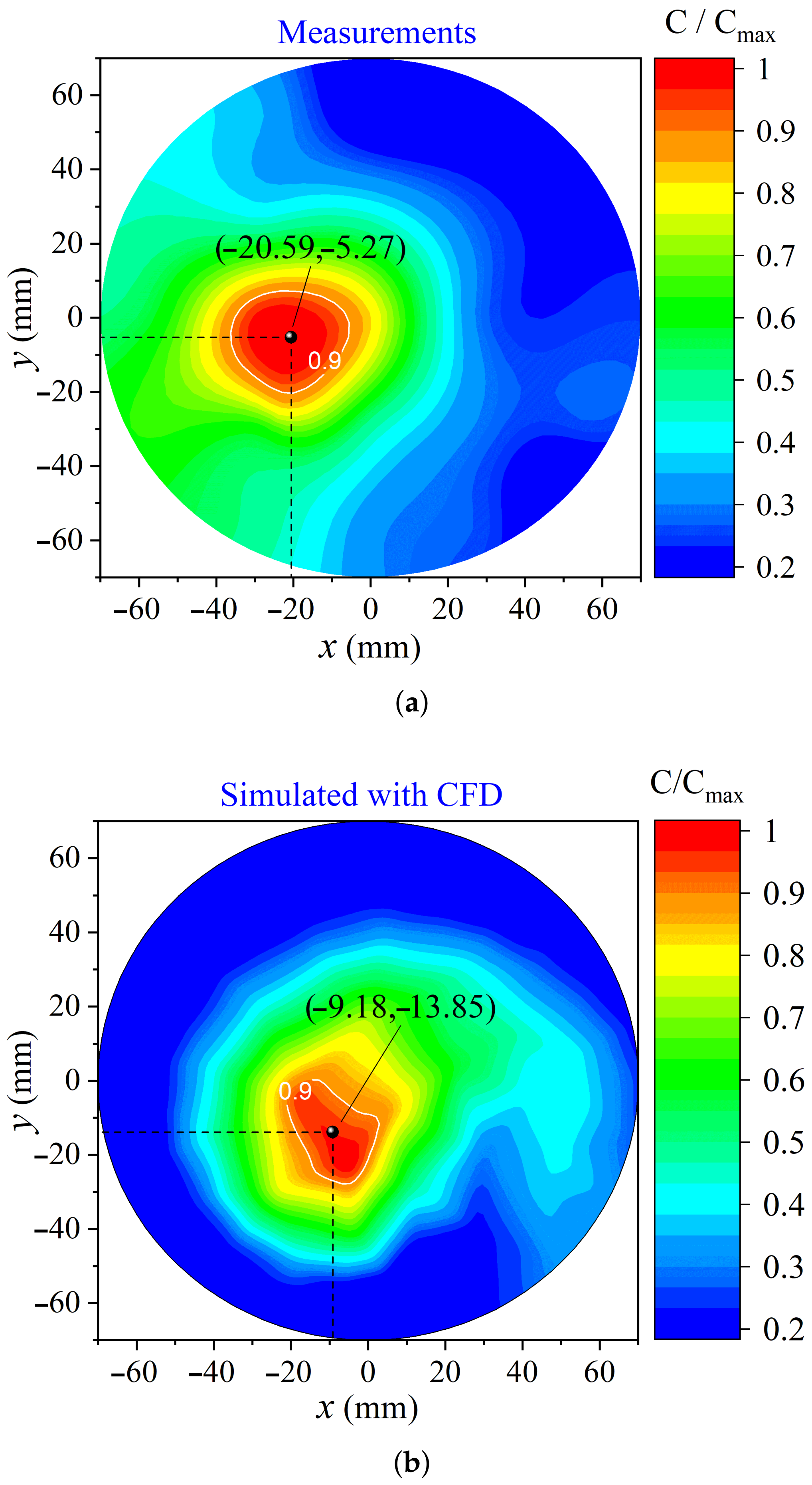
References
- Standard iec/ts 60034-27-2:2012(e); Rotating Electrical Machines—Part 27-2: Online Partial Discharge Measurements on the Stator Winding Insulation of Rotating Electrical Machines. International Organization for Standardization: Geneva, Switzerland, 2012.
- Dehlinger, N.; Stone, G. Surface partial discharge in hydrogenerator stator windings: Causes, symptoms, and remedies. IEEE Electr. Insul. Mag. 2020, 36, 7–18. [Google Scholar] [CrossRef]
- Cruz, J.S.; Fruett, F.; Lopes, R.R.; Takaki, F.L.; Tambascia, C.A.; Lima, E.R.; Giesbrecht, M. Partial Discharges Monitoring for Electric Machines Diagnosis: A Review. Energies 2022, 15, 7966. [Google Scholar] [CrossRef]
- Stone, G.C.; Sedding, H. Comparison of Low and High Frequency Partial Discharge Measurements on Stator Windings. In Proceedings of the Nordic Insulation Symposium, Tampere, Finland, 26 November 2019; pp. 134–138. [Google Scholar]
- Nair, R.P.; Vishwanath, S.B. Identification of Simultaneously Active PD Sources in Stator Insulation Using Variable Frequency Excitation. IEEE Trans. Dielectr. Electr. Insul. 2021, 28, 646–653. [Google Scholar] [CrossRef]
- Stone, G.C.; Sedding, H.; Veerkamp, W. What Medium and High Voltage Stator Winding Partial Discharge Testing Can-And Can Not-Tell You. In Proceedings of the 2021 IEEE IAS Petroleum and Chemical Industry Technical Conference (PCIC), San Antonio, TX, USA, 13–16 September 2021; pp. 293–302. [Google Scholar] [CrossRef]
- Caprara, A.; Ciotti, G.; Paschini, L. Analysis of the results of on-line Partial Discharge Monitoring and the impact of the maintenance actions on a 30 MVA synchronous generator. In Proceedings of the 2020 IEEE Electrical Insulation Conference (EIC), Knoxville, TN, USA, 22 June–3 July 2020; pp. 359–362. [Google Scholar] [CrossRef]
- Stone, G.C. Partial discharge diagnostics and electrical equipment insulation condition assessment. IEEE Trans. Dielectr. Electr. Insul. 2005, 12, 891–904. [Google Scholar] [CrossRef]
- Zhu, H.; Green, V.; Sasic, M.; Halliburton, S. Increased sensitivity of capacitive couplers for in-service PD measurement in rotating machines. IEEE Trans. Energy Convers. 1999, 14, 1184–1192. [Google Scholar] [CrossRef]
- Sedding, H.G.; Campbell, S.R.; Stone, G.C.; Klempner, G.S. A new sensor for detecting partial discharges in operating turbine generators. IEEE Trans. Energy Convers. 1991, 6, 700–706. [Google Scholar] [CrossRef]
- Stone, G.C.; Sedding, H.G.; Costello, M.J. Application of partial discharge testing to motor and generator stator winding maintenance. IEEE Trans. Ind. Appl. 1996, 32, 459–464. [Google Scholar] [CrossRef]
- McDermid, W.; Bromley, J.C. Experience with directional couplers for partial discharge measurements on rotating machines in operation. IEEE Trans. Energy Convers. 1999, 14, 175–184. [Google Scholar] [CrossRef]
- Dmitriev, V.; Oliveira, R.M.S.; Zampolo, R.F.; Vilhena, P.; Brasil, F.S.; Fernandes, M.F. Partial Discharges in Hydroelectric Generators; Springer International Publishing: Cham, Switzerland, 2023. [Google Scholar]
- Stone, G.C.; Culbert, I.; Boulter, E.A.; Dhirani, H. Electrical Insulation for Rotating Machines: Design, Evaluation, Aging, Testing, and Repair; Wiley-IEEE Press: Piscataway, NJ, USA, 2014; Volume 83. [Google Scholar]
- Buntat, Z.; Smith, I.; Mohd razali, N.A. Ozone Generation by Pulsed Streamer Discharge in Air. Appl. Phys. Res. 2009, 1, 2–10. [Google Scholar] [CrossRef]
- Zhu, Y.; Chen, C.; Shi, J.; Shangguan, W. A novel simulation method for predicting ozone generation in corona discharge region. Chem. Eng. Sci. 2020, 227, 115910. [Google Scholar] [CrossRef]
- Qin, Z.; He, Y.; Zhao, X.; Feng, Y.; Yi, X. A case analysis of turbulence characteristics and ozone perturbations over eastern China. Front. Environ. Sci. 2022, 10, 970935. [Google Scholar] [CrossRef]
- Langenberg, S.; Carstens, T.; Hupperich, D.; Schweighoefer, S.; Schurath, U. Technical note: Determination of binary gas-phase diffusion coefficients of unstable and adsorbing atmospheric trace gases at low temperature—Arrested flow and twin tube method. Atmos. Chem. Phys. 2020, 20, 3669–3682. [Google Scholar] [CrossRef]
- Ebadi Amooghin, A.; Mirrezaei, S.; Sanaeepur, H.; Moftakhari Sharifzadeh, M.M. Gas Permeation Modeling through a Multilayer Hollow Fiber Composite Membrane. J. Membr. Sci. Res. 2020, 6, 125–134. [Google Scholar] [CrossRef]
- Yanallah, K.; Pontiga, F.; Fernández-Rueda, A.; Castellanos, A.; Belasri, A. Ozone generation by negative corona discharge: The effect of Joule heating. J. Phys. Appl. Phys. 2008, 41, 195206. [Google Scholar] [CrossRef]
- Binder, E.; Draxler, A.; Muhr, M.; Pack, S.; Schwarz, R.; Egger, H.; Hummer, A. Effects of air humidity and temperature to the activities of external partial discharges of stator windings. In Proceedings of the 1999 Eleventh International Symposium on High Voltage Engineering, London, UK, 23–27 August 1999; Volume 5, pp. 264–267. [Google Scholar] [CrossRef]
- Petani, L.; Koker, L.; Herrmann, J.; Hagenmeyer, V.; Gengenbach, U.; Pylatiuk, C. Recent Developments in Ozone Sensor Technology for Medical Applications. Micromachines 2020, 11, 624. [Google Scholar] [CrossRef]
- Empowering Pumps & Equipment. Hydro Generator Refurbishment Increases Output by 15%. 2019. Available online: https://empoweringpumps.com/sulzer-hydro-generator-refurbishment-increases-output-by-15 (accessed on 19 May 2024).
- Oliveira, R.M.S.; Girotto, G.G.; Alcantara, L.D.S.; Lopes, N.M.; Dmitriev, V. Ozone Transport in 311 MVA Hydrogenerator: Computational Fluid Dynamics Modelling of Three-Dimensional Electric Machine. Energies 2023, 16, 8072. [Google Scholar] [CrossRef]
- Chung, T.J. Computational Fluid Dynamics; Cambridge University Press: Cambrige, UK, 2002. [Google Scholar]
- Oliveira, R.M.S.; Zampolo, R.F.; Alcantara, L.D.S.; Girotto, G.G.; Lopes, F.H.R.; Lopes, N.M.; Brasil, F.S.; Nascimento, J.A.S.; Dmitriev, V. Analysis of Ozone Production Reaction Rate and Partial Discharge Power in a Dielectric-Barrier Acrylic Chamber with 60 Hz High-Voltage Electrodes: CFD and Experimental Investigations. Energies 2023, 16, 6947. [Google Scholar] [CrossRef]
- Klauson, D. Physical and Chemical Properties of Ozone. 2005. Available online: https://www.eolss.net/Sample-Chapters/C07/E6-192-03.pdf (accessed on 19 May 2024).
- Cano-Ruiz, J.A.; Kong, D.; Balas, R.B.; Nazaroff, W.W. Removal of reactive gases at indoor surfaces: Combining mass transport and surface kinetics. Atmos. Environ. Part Gen. Top. 1993, 27, 2039–2050. [Google Scholar] [CrossRef]
- Williams, E.L.; Grosjean, D. Removal of atmospheric oxidants with annular denuders. Environ. Sci. Technol. 1990, 24, 811–814. [Google Scholar] [CrossRef]
- Simmons, A.; Colbeck, I. Resistance of various building materials to ozone deposition. Environ. Technol. 1990, 11, 973–978. [Google Scholar] [CrossRef]
- Mueller, F.X.; Loeb, L.; Mapes, W.H. Decomposition rates of ozone in living areas. Environ. Sci. Technol. 1973, 7, 342–346. [Google Scholar] [CrossRef] [PubMed]
- Cataldo, F.; Ursini, O. The Role of Carbon Nanostructures in the Ozonization of Different Carbon Black Grades, Together with Graphite and Rubber Crumb in an IR Gas Cell. Fuller. Nanotub. Carbon Nanostructures 2007, 15, 1–20. [Google Scholar] [CrossRef]
- Reiss, R.; Ryan, P.B.; Koutrakis, P.; Tibbetts, S.J. Ozone Reactive Chemistry on Interior Latex Paint. Environ. Sci. Technol. 1995, 29, 1906–1912. [Google Scholar] [CrossRef] [PubMed]
- Morrison, G.C. Ozone-Surface Interactions: Investigations of Mechanisms, Kinetics, MassTransport, and Implications for Indoor Air Quality. Ph.D. Thesis, University of California, Oakland, CA, USA, 1999. [Google Scholar]



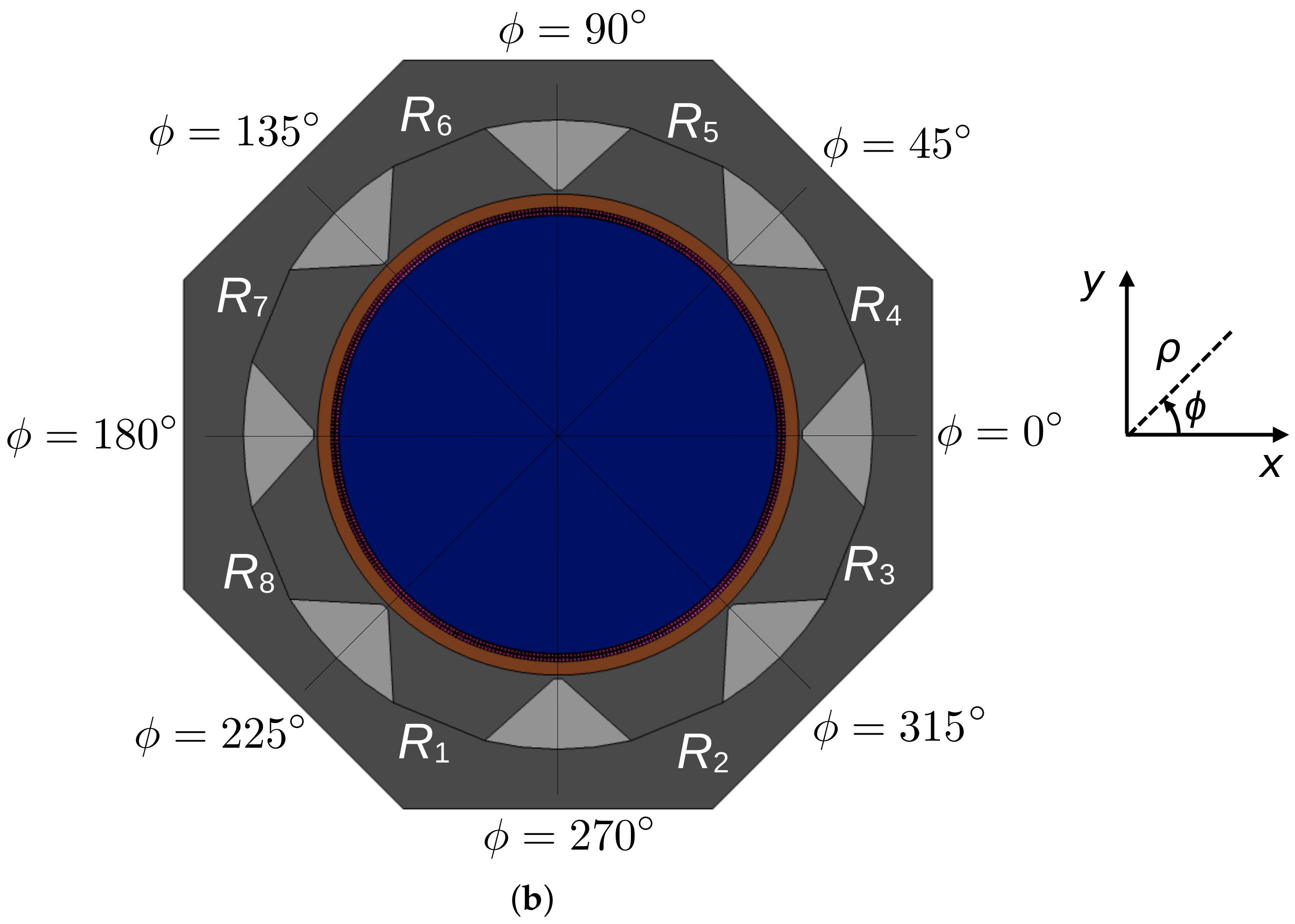





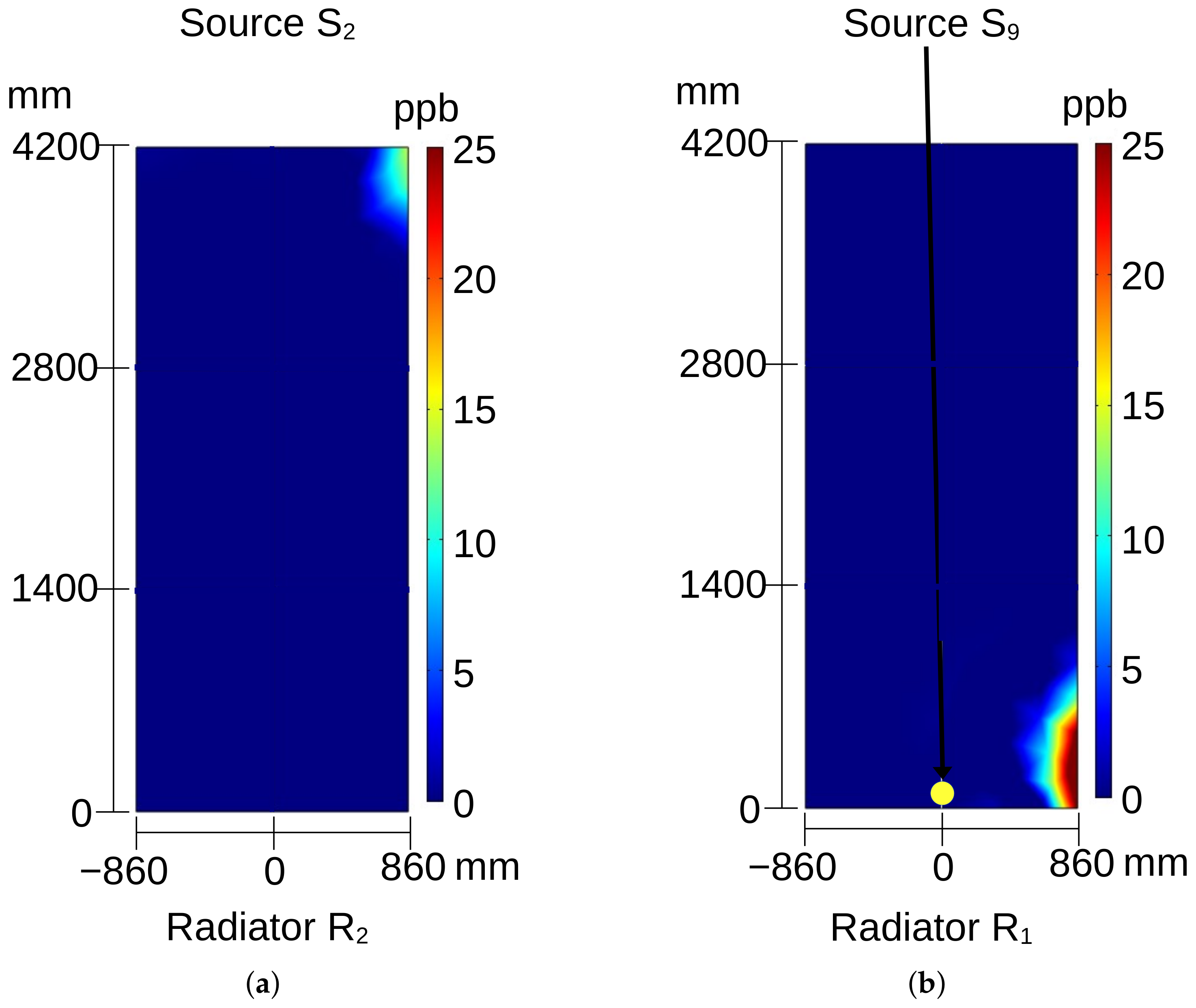


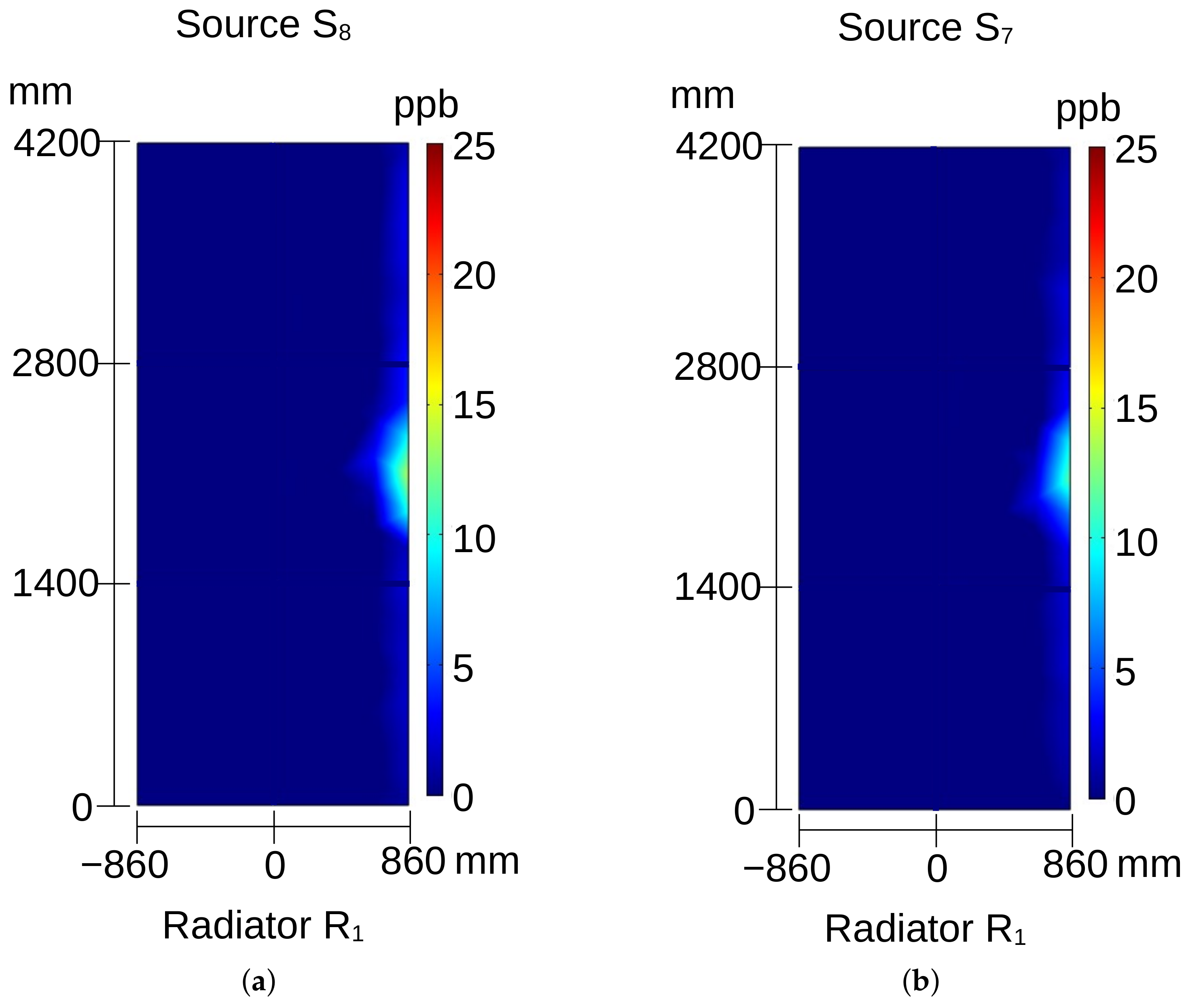
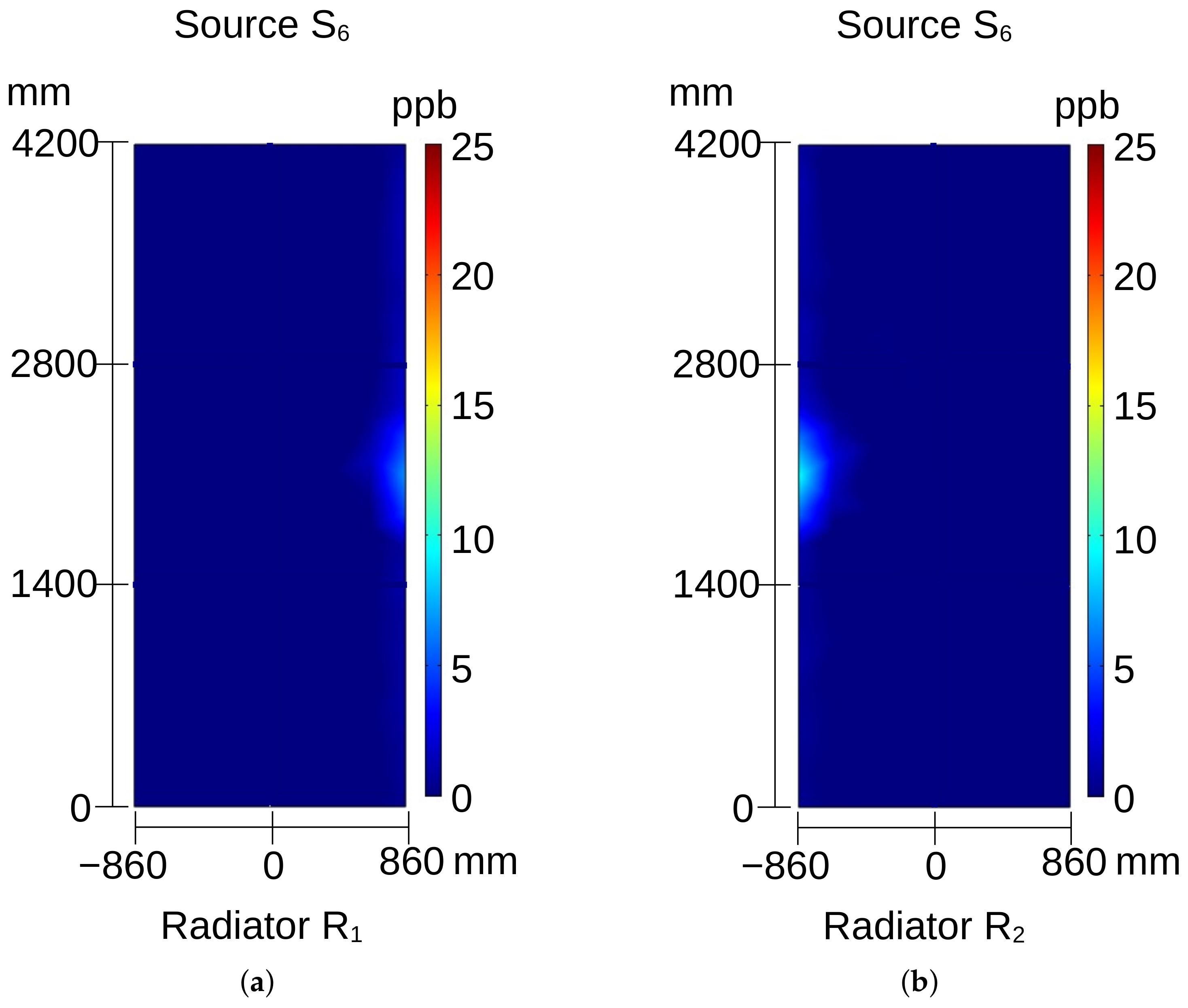
| Material | |
|---|---|
| Concrete | [30] |
| Stainless steel | [31] |
| Semiconductor coating layer | [32] |
| Epoxy | [33,34] |
| Source | Coordinate (mm) | Coordinate (Degrees) | z Coordinate (mm) |
|---|---|---|---|
| 3880 | 247.5 | 4020 | |
| 3880 | 268 | 4020 | |
| 3814 | 247.5 | 2100 | |
| 3871 | 247.5 | 2100 | |
| 3890 | 247.5 | 2100 | |
| 3814 | 268 | 2100 | |
| 3871 | 268 | 2100 | |
| 3890 | 268 | 2100 | |
| 3880 | 247.5 | 130 | |
| 3880 | 268 | 130 |
Disclaimer/Publisher’s Note: The statements, opinions and data contained in all publications are solely those of the individual author(s) and contributor(s) and not of MDPI and/or the editor(s). MDPI and/or the editor(s) disclaim responsibility for any injury to people or property resulting from any ideas, methods, instructions or products referred to in the content. |
© 2024 by the authors. Licensee MDPI, Basel, Switzerland. This article is an open access article distributed under the terms and conditions of the Creative Commons Attribution (CC BY) license (https://creativecommons.org/licenses/by/4.0/).
Share and Cite
Dmitriev, V.; de Oliveira, R.M.S.; de Alcantara, L.D.S.; Girotto, G.G. Localization of Partial Discharges in Hydrogenerators by Ozone Emission. Energies 2024, 17, 3173. https://doi.org/10.3390/en17133173
Dmitriev V, de Oliveira RMS, de Alcantara LDS, Girotto GG. Localization of Partial Discharges in Hydrogenerators by Ozone Emission. Energies. 2024; 17(13):3173. https://doi.org/10.3390/en17133173
Chicago/Turabian StyleDmitriev, Victor, Rodrigo M. S. de Oliveira, Licinius D. S. de Alcantara, and Gustavo G. Girotto. 2024. "Localization of Partial Discharges in Hydrogenerators by Ozone Emission" Energies 17, no. 13: 3173. https://doi.org/10.3390/en17133173






